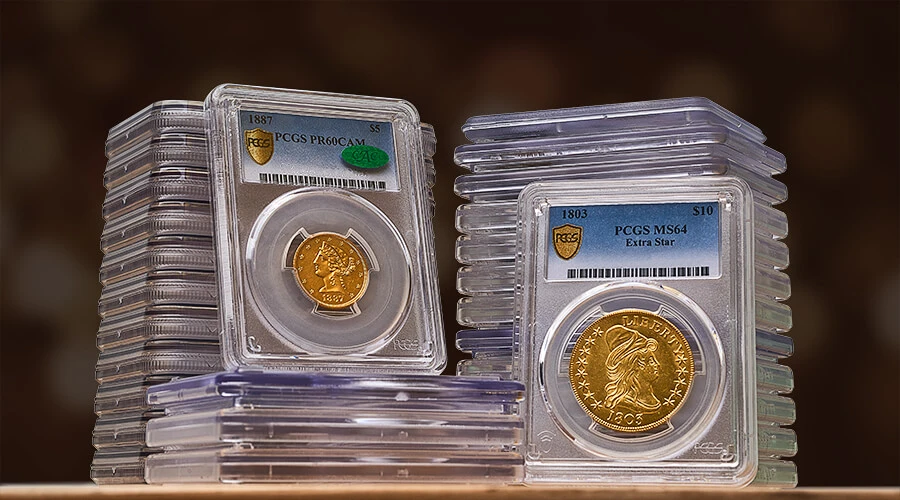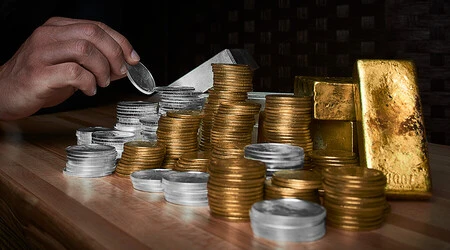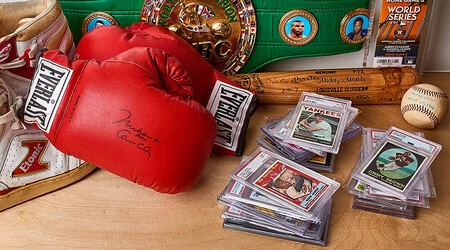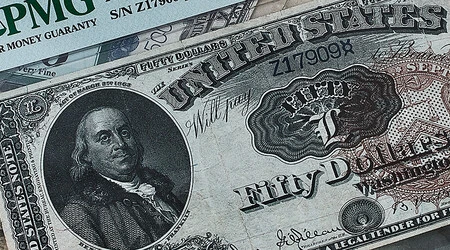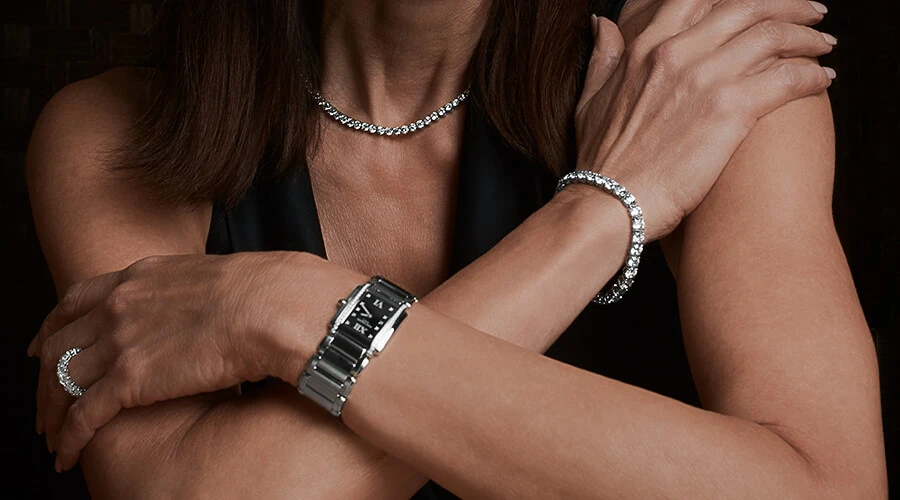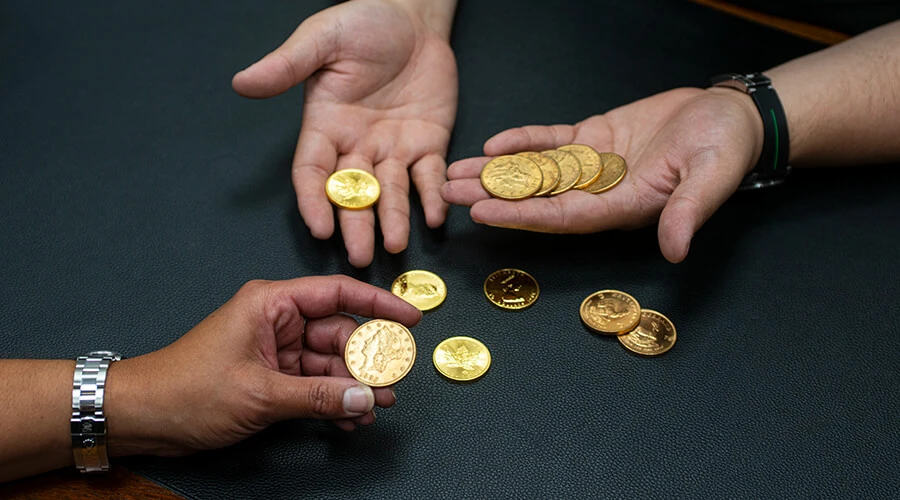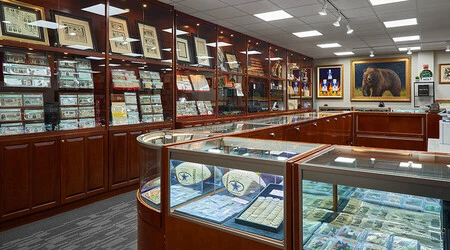The variety of collectible coins is vast and can be daunting to new and experienced collectors alike. Having clear cut goals is a great way to maintain focus and keep collections from straying. While some series have extreme rarities within, there are a number of series that present modest price tags and lend themselves to set building, especially to the novice. The iconic work of Adolf Weinman’s half dollar is actually both. The coins were issued from 1916 until 1947. The early examples can be pricey with many of the twenty examples elusive especially in the uncirculated grades. Many collectors cut their teeth on what is called the Short Set, which consists of twenty coins from 1941 to 1947 with all mint issues.
Each of the twenty are easily obtainable with premium quality examples available. The series offers a great primer in the three fundamentals of rare coin collecting – technical grading, strike evaluation and rarity. We can examine each in relation to the short set and help you sharpen your numismatic skills with this beautiful coin.
TECHNICAL GRADING
Rare coin grading is a subjective model that over time has proliferated through the numismatic community with widely accepted tenants. Each series in circulated condition has its own set of wear points, and detail acceptable for each step along the circulated grade spectrum. It’s not rocket science to recognize that coins wear naturally from the highest point inward. The wear points for classic rare coins have been studied since the inception of our Treasury and case studies exist for engravers at the Mint as well as numismatists in the collecting arena. Several great books and websites exist detailing this. Be sure and review our guide to grading.
Walkers are a great series to practice these fundamentals in both the circulated and uncirculated grade points. The central devices of the Walking Liberty half have distinct high points that prove one of the defining characteristics of this issue. Charles Barber, the chief engraver at the Mint at the time of original issue lamented at Weinman’s high central detail on both obverse and reverse motifs. This specifically makes quality production tough and lessens die life. Once in circulation, the coin wears heavily early. This characteristic bothered Barber whose job was to produce long lasting specie. But it makes the issue a great example of wear from use and with the higher reliefs clearly exhibiting the initial wear, the Walking Liberty Half is a great chalkboard on which to learn basic grading of circulated coins.
The obverse of the coin wears through the center initially eliminating the stripes on the gown, breast and hand across her hip. And with use, the coin will develop a virtual band of wear running north to south across these details. The reverse wears across the leg and breast of the eagle. This side will progressively wear in a band running across the eagle NW to SE, and at the top of the forefront wing.
Grading uncirculated Walkers in the upper gem and better grades is subjective, but the fundamentals are fairly easy to discern. When considering some of the early issues, especially the 1920’s San Francisco issues there is a bit of date relevant grading specific to the poorly struck nature of these issue. However one of the reasons we love the short set is absence of much of these issues. When grading uncirculated examples, examine the four basic focal areas - (in order of importance) the high points, the mid device details, the fields, and the peripheries.
An uncirculated example will have full luster across all surfaces . The amount of contact across the surfaces will determine the grade in the mint state ranges. The obverse high points are the head, and gown across the center. Imagine a line running from 12:00 to 6:00 and examine the coin from literally head to toe. These are the highest points and the main focal region for marking. Contact here will most affect the coin’s grade. Gems and better examples should be clean with minimal contact along this line with marks occurring in the regions outside of this central portion. The mid detail areas include the out stretched arm, remaining portions of the gown and sun. Some contact here will be acceptable but only major blemishes are grade limiting. The field is important as marks within the open areas are highly visible. With the Walker, the amount of open field is limited. The lettering can take some contact, and should be considered, but generally contact here is not distracting.
Grading is a non-tangible scale and grading uncirculated examples is not clearly delineated by number of hits or location of these based on the numeric grades. The differences can be subtle, with a hit along the thigh perhaps more prominent than a larger one that occurs in the olive branch. But, the Walker series is considered an easier coin to grade and the examination of a number of certified examples can be easily performed offering a quick educational base. When learning, you should try to look at as many coins in hand as possible. You cannot learn to grade from photographs. In a nutshell, the severity of contact determines the grade, with MS60 representing full luster having a large number of contact marks, and MS69 representing a pristine example. While learning to grade uncirculated coins stick with AU, MS63, MS65, and MS67 levels. Each will be visually separate for the grades surrounding it. Trying to learn the differences between a nice MS64, and a low end MS65 will slow your progress.
The circulated grades are more clearly defined as wear progresses in stages. Early stages of wear (AU – XF) will maintain original mint luster across the major detail, recesses and fields with just the highest points showing breaks in the luster. In the VF – F grades, wear of Liberty gets more extensive obliterating detail on her gown, bust and facial features. Generally luster in the fields will fade but will be evident around the lettering and in deeper portions of the design. The reverse wears in a similar fashion, lost will be the eagle’s main detail with the breast and legs worn flat. Some feather detail will remain, and all lettering will remain. In the lower grades (VG – AG) detail will be lost and only the deepest recesses will show soft original lines and modeling. Virtually no luster will be evident, if any. The date and lettering will remain, but the tops of letter begin to blend with the rim at GOOD and below. For collecting purposes don’t buy below VG, and for this series consider only XF or better.
STRIKING CHARACTERISTICS
The Walking Liberty Half is a great series to learn the fundamentals of strike. While modern mint production offers high production quality with the design and strike is maximized for full detail and mass production. This has not always been the case. The turn of the twentieth century and the renaissance of coin design had sculptors working with the Mint to produce some of the most spectacular issues in our nation’s history. However, the century of innovation that the Mint facilities and engravers herein had made in a virtual trial by error process was lost to the artists that lacked medallic art experience. A coin is produced in a press forcing the planchet metals to be pushed into the recesses of a die. The depth of this die and the amount of pressure determines the outcome. With the Walker, the high points run across the central portion of both obverse and reverse forcing the presses to push metal both up and down simultaneously. The result is not always perfection. The strike variations are especially evident in uncirculated examples making the series a visual classroom for new collectors.
The short set dates are all mostly well struck with good detail available in almost every issue. The San Francisco Mint infamously used lower pressure to extend die life and thus many of the examples from the West Coast show some weakness, especially the short set key 1941-S. To determine the strength of strike on the obverse examine the hand across the hip, a full strike will show full thumb detail. A weaker impression begins to limit the amount of detail in this high point and along the leg beneath. There are uncirculated examples with no hand detail and gown lines. In fact, it is common to find a 1941-S in MS63 or MS64 with little to no hand detail. These should not be confused with AU graded halves. Rotating the coin in the light will show luster across the regions even with the lack of detail. It is this strike detail that it may take some effort to flatten the learning curve, but visually inspecting coins in hand will sharpen your eye and quickly enable you to determine the premium quality examples from the average. The reverse eagle suffers from a similar malady. Feather detail can be lost across the eagle forward leg and high tip of the wing. Again, weak strike characteristics should not be considered wear and luster present will be noticeable. The grades in gem and better should have good to fully struck devices, but otherwise, strike is a function of eye appeal rather than actual technical grade.
INHERENT AND CONDITION RARITY
Rarity can be divided into two categories – inherent and conditional rarity. The inherent rarity refers to the initial mintage figures and distribution of the coins. Some coins have low mintages, but were not put into circulation, rather they were stored at banks and thus survival over time is high so inherent rarity is low. This is the case with most common date Morgan dollars, and only somewhat applicable to the Walker series. The short set dates have higher mintage figures than the earlier dates with most being produced in numbers exceeding ten million. While many of the examples from the earlier years of the series were used for commerce and lost to attrition making many of the teens, twenties and thirties more scarce for today’s collectors, many of the dates in the short set range were purchased by coin dealers in BU bank wrapped rolls. This was common during the last half of the 20th century.
Conditional rarity is how many survived in various conditions. When you look at these numbers across the Walker Short Set you can get a good feel for pricing and value. Another reason why this set is a great way to learn basic collecting strategy. Third party grading has collected this data for three decades now and offer population reports to help us easily look through and get a feel for condition rarity trends. Let’s look at a couple of dates and get a feel for how this ratio works. Reviewing population data, one must consider the tainted nature of this data. First, if the value of a coin is below $75, the data is skewed by lack of submission. It’s hardly worth the fees and shipping associated with that amount, if a $50 certified coin can be sold for $40 without the efforts and costs associated with having it graded. So, when comparing date to date, especially in grades under MS65, the ratios are to be taken with a grain of salt. On the other end, the records of coins in grades behind price jumps tend to be higher than true populations as resubmissions are not accurately reported in the population data.
EXAMPLE #1
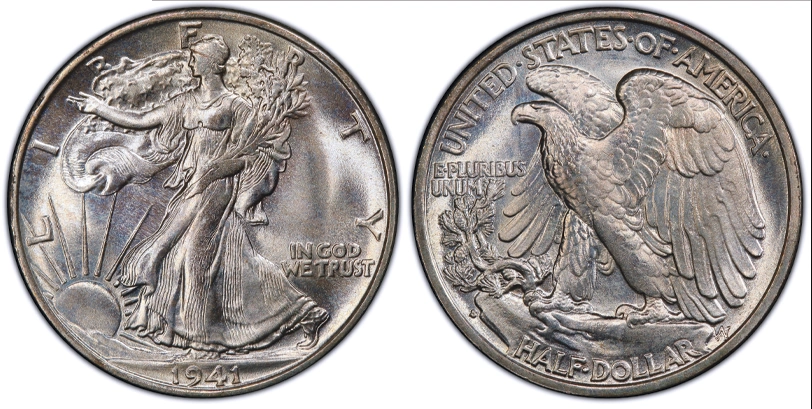
The 1941-S is considered the key to the short set. It has a lower mintage of just over 8 million, which is not the lowest for the set, but it is significantly lower than the most common. In MS65 PCGS shows 2,812 examples. This is the lowest among the twenty dates. The more common dates in the series show 5,000 to 8,000+. Thus the 1941-S is “conditionally” more rare than the others, and the lower mintage makes them inherently more rare. Add in the higher demand for better dates and you get an added value. The date in MS65 should sell between $350 and $500 depending on grading service and eye appeal.
EXAMPLE #2
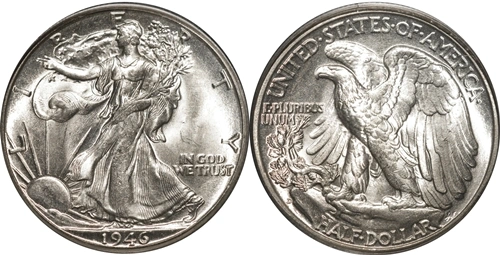
The 1946-D has the lowest mintage of any of the short set dates at 2,151,000. This number is actually in line with some of the twenties dates that are scarce in BU. However, as mentioned previously many of these dates were saved in BU condition and the survival rates are extremely high. The date shows over 10,000 coins graded MS65 by PCGS. Thus despite the inherent rarity the date trades as common. An MS65 should cost between $75 and $100 depending on grading service and eye appeal.
These examples are intended to quickly give you an idea of how pricing works, and how to factor value. There is no set formula and coin pricing works with a loose algorithm of inherent and condition rarity coupled with eye appeal and overall demand. Every series has its quirks and characteristics shared by collectors of that denomination and type. The Walker Short Set is an inexpensive and beautiful collection that is both fun and educational. Most of the coins in the series can be purchased in circulated grades for just over silver value. BU examples can be purchased in MS63 for under $100. The set is still affordable in gem with common dates in MS65 currently around $100 or less.
Regardless of your collector level, we invite you to explore the series. Visit the store to speak with any of our staff on how we can assist you in building the set. Whether you’re looking to fill a Whitman folder with circulated examples or working toward a high end Registry set, we are here to help. U.S. Coins and Jewelry maintains a large inventory of both raw and certified examples, and our trained staff members are eager to help you learn what you need to reach your collecting goals.












